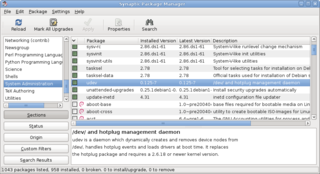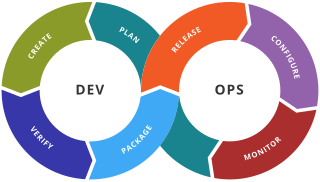
Configuration management (CM) is a systems engineering process for establishing and maintaining consistency of a product's performance, functional, and physical attributes with its requirements, design, and operational information throughout its life. The CM process is widely used by military engineering organizations to manage changes throughout the system lifecycle of complex systems, such as weapon systems, military vehicles, and information systems. Outside the military, the CM process is also used with IT service management as defined by ITIL, and with other domain models in the civil engineering and other industrial engineering segments such as roads, bridges, canals, dams, and buildings.

A package manager or package-management system is a collection of software tools that automates the process of installing, upgrading, configuring, and removing computer programs for a computer in a consistent manner.
In software engineering, software configuration management is the task of tracking and controlling changes in the software, part of the larger cross-disciplinary field of configuration management. SCM practices include revision control and the establishment of baselines. If something goes wrong, SCM can determine the "what, when, why and who" of the change. If a configuration is working well, SCM can determine how to replicate it across many hosts.

Advanced package tool, or APT, is a free-software user interface that works with core libraries to handle the installation and removal of software on Debian, and Debian-based Linux distributions. APT simplifies the process of managing software on Unix-like computer systems by automating the retrieval, configuration and installation of software packages, either from precompiled files or by compiling source code.
Rational ClearCase is a family of computer software tools that supports software configuration management (SCM) of source code and other software development assets. It also supports design-data management of electronic design artifacts, thus enabling hardware and software co-development. ClearCase includes revision control and forms the basis for configuration management at large and medium-sized businesses, accommodating projects with hundreds or thousands of developers. It is developed by IBM.
Product data management (PDM) is the name of a business function within product lifecycle management (PLM) that denotes the management and publication of product data. In software engineering, this is known as version control. The goals of product data management include ensuring all stakeholders share a common understanding, that confusion during the execution of the processes is minimized, and that the highest standards of quality controls are maintained. PDM should not be confused with product information management (PIM).
Information technology service management (ITSM) are the activities performed by an organization to design, build, deliver, operate and control information technology (IT) services offered to customers.
Maven is a build automation tool used primarily for Java projects. Maven can also be used to build and manage projects written in C#, Ruby, Scala, and other languages. The Maven project is hosted by The Apache Software Foundation, where it was formerly part of the Jakarta Project.
Software deployment is all of the activities that make a software system available for use.
The term configuration item (CI) refers to the fundamental structural unit of a configuration management system. Examples of CIs include individual hardware or software components. The configuration-management system oversees the life of the CIs through a combination of processes and tools by implementing and enabling the fundamental elements of identification, change management, status accounting, and audits. This system aims to avoid the introduction of errors related to lack of testing as well as of incompatibilities with other CIs.
Microsoft Visual SourceSafe (VSS) is a discontinued source control program oriented towards small software development projects. Like most source control systems, SourceSafe creates a virtual library of computer files. While most commonly used for source code, SourceSafe can handle any type of file in its database, but older versions were shown to be unstable when used to store large amounts of non-textual data, such as images and compiled executables.
rPath, Inc. was a technology company based in Raleigh, North Carolina, that developed technology to automate the process of constructing, deploying, and updating software. rPath modeled and managed components and dependencies under version control. It acted as a model-driven and version-controlled repository and software distribution hub.
A configuration management database (CMDB) is an ITIL term for a database used by an organization to store information about hardware and software assets. It is useful to break down configuration items into logical layers. This database acts as a data warehouse for the organization and also stores information regarding the relationships among its assets. The CMDB provides a means of understanding the organization's critical assets and their relationships, such as information systems, upstream sources or dependencies of assets, and the downstream targets of assets.
Customer Configuration Updating (CCU) is a software development method for structuring the process of providing customers with new versions of products and updates production. This method is developed by researchers of the Utrecht University.
In software development, version control is a class of systems responsible for managing changes to computer programs or other collections of information such that revisions have a logical and consistent organization. The following tables include general and technical information on notable version control and software configuration management (SCM) software. For SCM software not suitable for source code, see Comparison of open-source configuration management software.
Build automation is the process of automating the creation of a software build and the associated processes including: compiling computer source code into binary code, packaging binary code, and running automated tests.
A software repository, or repo for short, is a storage location for software packages. Often a table of contents is also stored, along with metadata. A software repository is typically managed by source or version control, or repository managers. Package managers allow automatically installing and updating repositories, sometimes called "packages".
Aldon is a business unit of Rocket Software. It develops, manufactures, licenses and supports software change management products for the enterprise application lifecycle management (ALM) and software change management (SCM) markets.
AnthillPro is a software tool originally developed and released as one of the first continuous integration servers. AnthillPro automates the process of building code into software projects and testing it to verify that project quality has been maintained. Software developers are able to identify bugs and errors earlier by using AnthillPro to track, collate, and test changes in real time to a collectively maintained body of computer code.

A DevOps toolchain is a set or combination of tools that aid in the delivery, development, and management of software applications throughout the systems development life cycle, as coordinated by an organisation that uses DevOps practices.




